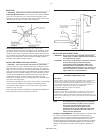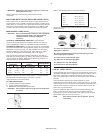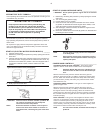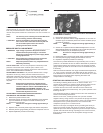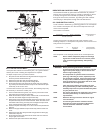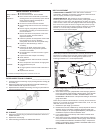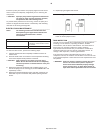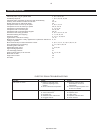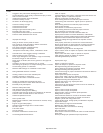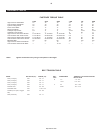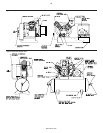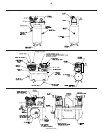
The basic principle of operation is as follows: On the suction stroke
of the first-stage piston(s), air at atmospheric pressure enters the
cylinders through the inlet filter(s) and then the inlet valves located
in the head. On the compression stroke of the first-stage piston(s),
the air is compressed to an intermediate pressure and discharged
through the discharge valves(s) into common manifold(s). From the
manifold(s) the air passes through the intercooler tubes, where the
heat of first-stage compression is removed. On the suction stroke of
the second-stage piston this cooled air enters the second-stage
cylinder through the inlet valve. The compression stroke of the
second-stage piston compresses the air to the final discharge
pressure and forces it out through the discharge valve into the
receiver tank or system. If cooling of the discharge air is required,
an air-cooled aftercooler should be installed between the
compressor discharge and the receiver tank or system.
For maintaining the receiver tank or system air pressure within
predetermined limits, the compressor may be operated with
automatic start & stop control or constant speed control regulation.
The type of regulation used depends upon the application.
ADDITIONAL REFERENCES___________________________
Unless otherwise stated, dimensions, weights and measurements
are provided in standard U.S. measure followed in parentheses by
the metric conversion. Any torque values given are stated in inch or
foot pounds followed by the Newton-meter equivalent in
parentheses. Electrical characteristics are given in
voltage-phase-hertz.
RECEIPT & INSPECTION
Ensure adequate lifting equipment is available for unloading and
moving the unit to the installation site.
NOTE Lifting equipment must be properly rated for the
weight of the unit.
•CAUTION Lift the unit by the shipping skid only. Do not use
the motor lifting eye to lift the entire unit. The motor
lifting eye is for removing the motor from the unit
only.
•
CAUTION! Do not work on or walk under the unit while it is
suspended.
Before signing the delivery receipt, inspect for damage and missing
parts. If damage or missing parts are apparent, make the
appropriate notation on the delivery receipt, then sign the receipt.
Immediately contact the carrier for an inspection.
All material must be held in the receiving location for the carrier’s
inspection.
Delivery receipts that have been signed without a notation of
damage or missing parts are considered to be delivered “clear.”
Subsequent claims are then considered to be concealed damage
claims. Settle damage claims directly with the transportation
company.
If you discover damage after receiving the unit (concealed damage),
the carrier must be notified within 15 days of receipt and an
inspection must be requested by telephone with confirmation in
writing. On concealed damage claims, the burden of establishing
that the unit was damaged in transit reverts back to the claimant.
Read the unit nameplate to verify it is the model ordered, and read
the motor nameplate to verify it is compatible with your electrical
conditions. Make sure electrical enclosures and components are
appropriate for the installation environment.
INSTALLATION
SELECTING A LOCATION _____________________________
ELECTRIC MOTOR UNITS. For most electric motor units, select a
relatively clean and dry well-lighted indoor area with plenty of space
for proper ventilation, cooling air flow and accessibility. Provide
1,000 cubic feet of fresh air per 5 horsepower. Locate the unit at
least 15 inches (38 cm) from walls, and make sure the main power
supply is clearly identified and accessible.
Unless the electrical components of the unit are specially protected
for outdoor use, do not install an electric motor unit outdoors or in
an area that will expose the electrical components to rain, snow or
sources of appreciable moisture.
WARNING FOR UNITS EQUIPPED
WITH ELECTRIC DRAIN VALVE
•
WARNING The electric drain valve incorporates arcing or
sparking parts, such as snap switches, receptacles
and the like that tend to produce arcs or sparks
and, therefore, when located in a garage, the
compressor should be in a room or enclosure
provided for the purpose, or the electric drain
valve should be 18 inches (457 mm) or more above
the floor.
GASOLINE ENGINE UNITS. For gasoline engine units, keep the
engine at least 3 feet (1 m) away from building walls and other
equipment. Install the unit in a location with plenty of space for
proper ventilation, cooling air flow and accessibility. Do not install or
operate a gasoline engine unit in a confined area.
AMBIENT TEMPERATURE CONSIDERATIONS. Ideal operating
temperatures are between 32°F and 100°F (0°C and 37.8°C). If
temperatures consistently drop below 32°F (0°C), install the
compressor in a heated area. If this is not possible, you must
protect safety/relief valves and drain valves from freezing. If
temperatures are consistently below 40°F (4.4°C), consider
installing an external crankcase heater kit, especially if the
compressor has difficulty starting.
•
CAUTION Never operate the compressor in temperatures
below -15°F (-26.1°C) or above 125°F (51.0°C).
HUMID AREAS. In frequently humid areas, moisture may form in
the pump and produce sludge in the lubricant, causing running parts
to wear out prematurely. Excessive moisture is especially likely to
occur if the unit is located in an unheated area that is subject to
large temperature changes.
Two signs of excessive humidity are external condensation on the
pump when it cools down and a “milky” appearance in petroleum
lubricant.
You may be able to prevent moisture from forming in the pump by
increasing ventilation, operating for longer intervals or installing an
external crankcase heater kit.
NOISE CONSIDERATIONS. Consult local officials for information
regarding acceptable noise levels in your area. To reduce excessive
noise, use vibration isolator pads or intake silencers, relocate the
unit or construct total enclosures or baffle walls.
2
http://air.irco.com





